Flone, The Flying Phone
Posted in: Uncategorized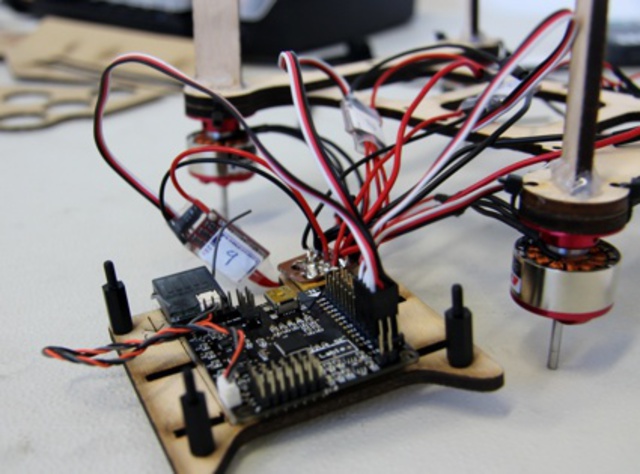


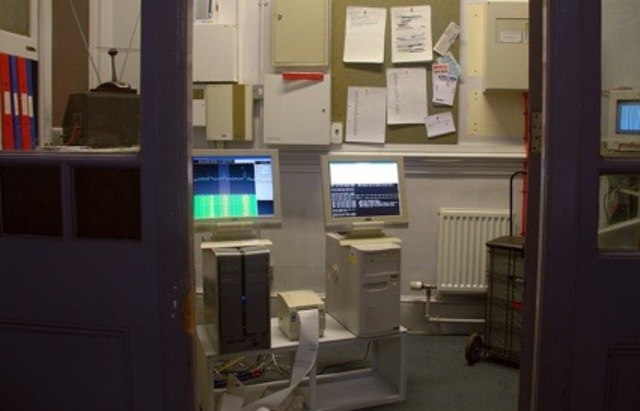
The Helga de Alvear gallery in Madrid is currently running a (very timely) exhibition on the controversial topic of Extraordinary Rendition. The expression was coined by the Bush administration to define new legal measures designed to sidestep the existing Human Rights system and deprive some individuals from its protection in the name of the fight against terrorism.

Detainees at Camp X-Ray, at Naval Base Guantanamo Bay, Cuba
The Patriot Act, for example, expands the authority of US law enforcement agencies for “terrorism investigation.” It limits -when it does not completely abolish it- citizens’ right to privacy or freedom of expression, allows for kidnapping and confinement of persons without charges, without trial or a detention period as has been happening in Guantanamo since 2002.
The gallery invited four renowned artists to reflect on the issue.
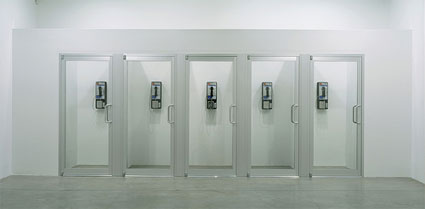
Elmgreen and Dragset, Phone Home, 2008
Phone Home (2003), by Elmgreen & Dragset, is the only work on exhibit that has not been created specifically for the show. The installation looks at the loss of the right to privacy in communications. Five telephone cabins are lined up in the gallery. A note informs visitors that they can call anyone they want in the world for free. Of course there’s a trick: the conversation you are planning to have will be broadcast in the gallery, recorded and a table with audio players and headphones will enable future visitors to listen to what you said.
Under the new rules of extraordinary rendition, physical and psychological torture is justified. Spanish Inquisition-like methods of torture get toned down but that’s because some of them are given new names, like waterboarding, in an attempt to disguise their true meaning.
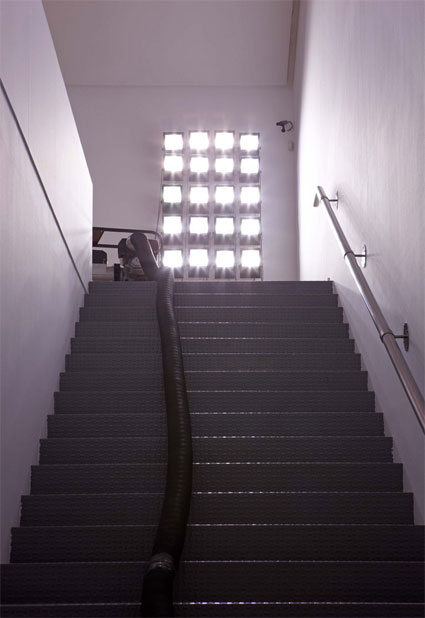
Santiago Sierra, Público iluminado con generador de gasolina, 2008
True to his wam bam approach, Santiago Sierra chose to address torture and one of its most commonly applied methods: the sleep deprivation of detainees for days and months. A huge spotlight operated by a generator are the only elements in Público iluminado con generador de gasolina [Public illuminated by oil generator]. Unfortunately the gallery had run out of oil (another very timely issue) when i went there and the installation was turned off.
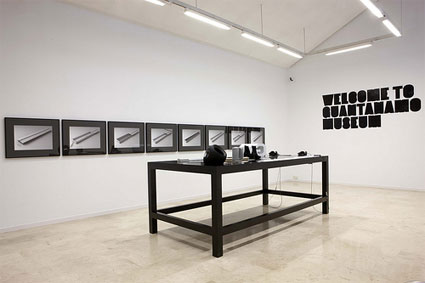
Alicia Framis, Welcome to Guantanamo, 2008. Image courtesy of GalerÃa Helga de Alvear, Madrid
Alicia Framis is presenting the first part of a wider project called Welcome to Guantánamo Museum. The installation documents the key elements that would form this hypothetical museum on the US detention centre in Cuba. Scale models, drawings, prototypes, floor plans and structures are exhibited together with an audio piece created with Enrique Vila Matas and Blixa Bargeld. The project echoes our society’s need to museify everything, think of Auschwitz and Alcatraz. Should we recoil at the idea of turning horror into a tourist attraction or should we decide that such museums are not a necessary evil, a way of ensuring that atrocities are not forgotten?
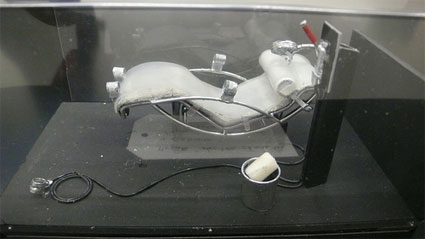
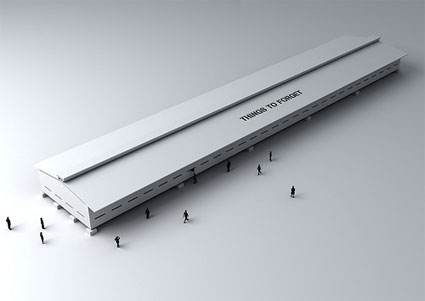
Alicia Framis, Welcome to Guantanamo, 2008. Image courtesy of GalerÃa Helga de Alvear, Madrid
The proposal for a Guantanamo Museum will include a selection of exhibition objects and merchandising that reflect the museum’s theme and motto — Things to forget. There will be a Le Corbusier chaise longue turned into an electric chair, a non-existent mailbox, shoes which contain inside their heels a system to allow prisoners to commit suicide, a series of orange clothing and objects designed by Framis together with students during workshops, furniture for the museum will be designed and built using the material of inmates’ cells, etc. At the same time a sound room will recall the names of all the caged prisoners in Guantanamo.
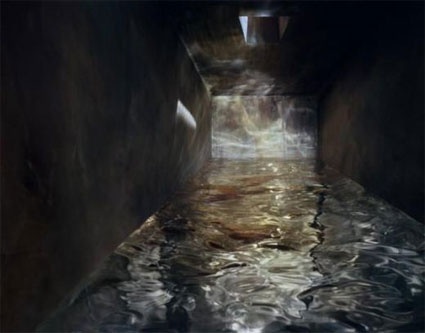
James Casebere, Flooded cell #2, 2008
James Casebere made photos of what he calls Flooded Cells. These images conjure up allusions to prisons, claustrophobic and oppressive spaces somehow reminiscent of Piranesi‘s fictitious and distressing prisons (carceri) yet also referencing the method of torture by simulated drowning.
Extraordinary is part of the Off programme of PhotoEspana. You can see the show until July 19 at the Helga de Alvear gallery in Madrid. My images.
Related stories: Trevor Paglen’s talk at Transmediale, Interview with the Institute for Applied Autonomy, They make art not bioterrorism, Tracking the Torture Taxis.
The reason for my presence at etech08 this year was the “art fest” that i set up with the super nice and super smart Kati London, an itp graduate who currently works as a senior producer at area/code in New York and as an artist responsible for projects such as Botanicalls Twitter DIY and You Are Not Here.
Brady Forrest had the idea to organize this first ETech Emerging Arts Fest and we are infinitely grateful to him. We had our friendly debates and doubts but he is the first person who listened to our complains that artists should be given a voice in all those big technology conferences. The theme of the event was “Awareness” and we selected works that bridged the gap between perception and understanding. In retrospect i realize that Brady selected the geekiest pieces, Kati (who actually did most of the work) chose the playful ones and i went for information visualization.
Kati and i invited Brooke Singer to join us for a panel which attempted to illustrate the whole idea of awareness to the conference attendees. Because i’m never really interested in writing about my own presentations and because i’ve covered the work of Brooke several times (and will keep on doing so in the future), i’ll just focus on Kati’s talk.
She gave me the authorization to publish her slides so here they are:
And here the notes i took while she was talking:
She compared artists to hackers, they are the one giving the one finger salute to mainstream technology, they have ideas, go against the grain and keep on pushing their own inspiration forward no matter the resistance.
Today, we have more and more tools which empower people: OS hardware and software, library, there’s also a revival of the DIY culture, Arduino and Processing are increasingly successful, etc. Suddenly being creative with technology becomes possible for a larger number of people. How does this spirit translate when we think about “awareness”?
Kati then focused on several projects which, according to her, best embody the idea of awareness.
1. Invisible: Waste processes
drinkpeedrinkpeedrinkpee, by Rebecca Bray and Britta Riley, includes an installation and a diy kit for turning your pee into fertilizer for houseplants.

What happens when we think of our bodies as their own ecosystems? Are they open or closed ecosystems? Where do we draw the boundaries? Before we take medication, do we ask ourselves how it will affect our internal organs, our friendly bacteria? What is our medication’s future, beyond our bodies, in the sewage system and out in the waterways we swim in and eventually drink? What are the possible futures of our personal waste? What do sentient ecosystems eat and drink?
Human urine is actually sterile (unlike faeces, it is bacteria-free) and it can be a rich food source if it gets into the right part of the right ecosystem. Now, most human urine travels untreated into the waterways and is a significant cause of eutrophication, a toxic condition caused by harmful algae blooms, in the oceans. The excess nitrogen and phosphorus in our urine overfeeds algae and suffocates fish.
However, a biological waste treatment process developed at EAWAG Aquatic Research in Switzerland can extract this phosphorus & nitrogen for use as a fertilizer, leaving the rest of urine almost harmless to aquatic life. This kit gives users the opportunity to replicate the technique at home and fertilize their plants with their own pee.
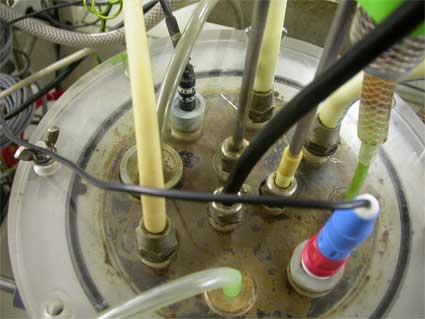
Bioreactor to stabilize urine, photo Eawag
The installation will be on view and the DIY kits will be available at the exhibition FEEDBACK at Eyebeam, March 13 – April 19, 2008.
2. Invisible: Animal Behavior Patterns
Joshua Klein built a vending machine that teaches crows to deposit coins in exchange for peanuts. Crows are surprisingly (for me) intelligent. Their brain/body weight ratios are similar to chimpanzees. Look at the image below, seagulls don’t get the vending machines but those smart little crows seem to understand that there’s something worth their attention there.
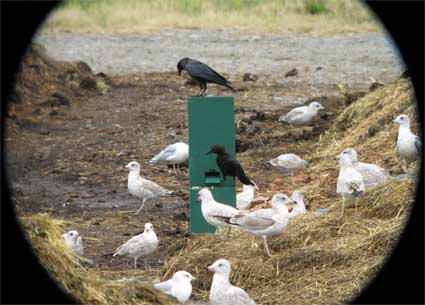
Once he has fine-tuned the vending machine training, his plan is to train crows for search and rescue, picking up trash, and other mutually beneficial tasks (via boing boing). The machine is only the first step in his quest for “interspecies harmony.”
3. Invisible: Social Connections
 Generative Social Networking, by Andrew Schneider and Christian Croft, uncovers the dark sides of social networks by exposing their vulnerability. The software uses bluesnarfing to open the mobile phonebooks of people using security loophole-laden Bluetooth devices. This phonebook data is then fed through the GSN System. Unbeknownst to the phone owner, the device betrays its list of phone numbers to a laptop. An Asterisk phone server will then generate a “conversation” with each number in the list. The first number on the list is called and receiver’s response recorded. The next number on the list is called, the first number’s initial response is played back to the new number, and the new number’s response to the old number’s prompt is recorded. This continues for however many phone numbers are in the contact list.
Generative Social Networking, by Andrew Schneider and Christian Croft, uncovers the dark sides of social networks by exposing their vulnerability. The software uses bluesnarfing to open the mobile phonebooks of people using security loophole-laden Bluetooth devices. This phonebook data is then fed through the GSN System. Unbeknownst to the phone owner, the device betrays its list of phone numbers to a laptop. An Asterisk phone server will then generate a “conversation” with each number in the list. The first number on the list is called and receiver’s response recorded. The next number on the list is called, the first number’s initial response is played back to the new number, and the new number’s response to the old number’s prompt is recorded. This continues for however many phone numbers are in the contact list.
More fun with the video.
In January, i was in Hungary to visit Kitchen Budapest. Before i head to a review of what i’ve seen in the geek alcove, i’m going to list a few surprises i encountered while i was walking through the capital:
I don’t know what is the matter with their public statues but some get tortured with fierce cruelty (must have something to do with the moustache):
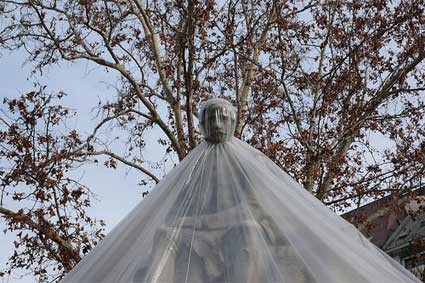
Workers have some really classy hats:
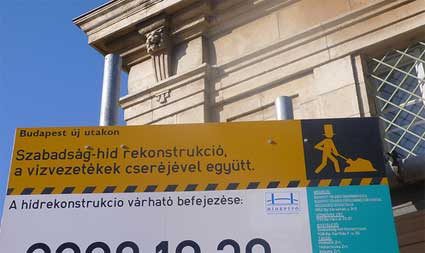
Santa has more fun there than anywhere else in the world

On January 26, the KiBu lab was opening its doors for a Kibu.Projects.Social event to present all Kitchen Budapest projects, get feedback on their work from visitors, drink hot chocolate and end the evening with performances.
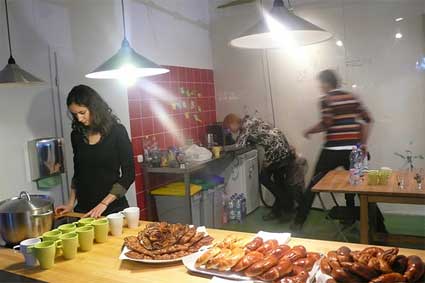
Kitchen Budapest, a new media lab which opened its doors in June 2007, invites researchers, designers and artists to explore the convergence of mobile communication, online communities and urban space but also their impact on our society. Its director is Adam Somlai-Fischer whose work with Aether Architecture you probably know.
Some of the prototypes presented in January were developed over several months, others took only a couple of weeks to form. KiBu is sponsored by a telecom company but that doesn’t mean that its projects stop at the end of the phone antenna: the KiBuists are having fun with blenders, lamps, games, plants, gym, etc.
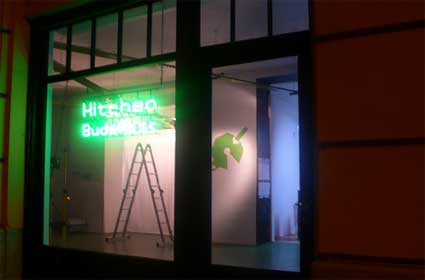
They work in team of people coming from very different backgrounds who mix and teach each other their passion and knowledge.
Now about (some of) the projects:
Eco Gym made me laugh out loud.
First you have this home bicycle which belonged to the mother of one of the KiBu designers. Well, i think that this bicycle is gorgeous, it belongs to a museum. Not that the KiBu people care that much, they simply dragged it to the lab and turned it into an eco-conscious experiment (a bit like Myriel Milicevic‘s Human Powered workshop in Antwerp last year).
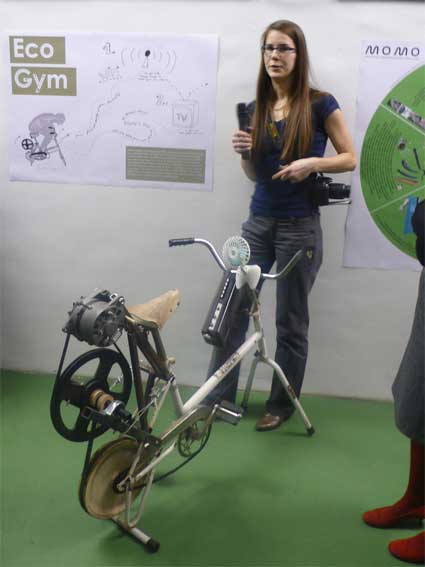
The bicycle is the first prototype of a group of projects which will harvest the energy of its user’s own activity and use it to power the light for example. The idea is to have a whole gym where energy wasting does not exist. The energy of users sweating on a training machine would power the whole gym: light, sound system, air-con, etc.
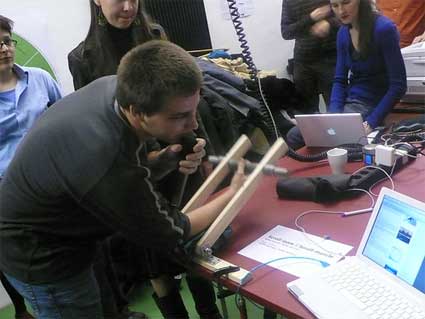
The same team of designers is also working on MOMO, a series of smaller applications which would motivate you to engage in physical activities during your daily routine. They were showing the Scroll-Muscle machine (image above), a system which forces you to flex your arm and exercise your biceps/triceps each time you scroll down a webpage.
Landprint is a really really really nice project I mentioned earlier but i was glad to finally be able to discuss with its designers.
The work is still very much in progress.
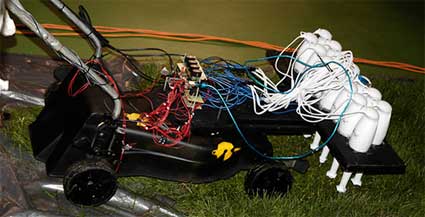
The main idea of Landprint is to develop a program-manipulated plant cultivation system, it would reproduce subtle patterns and photos by combining various species of plants with programmed robotics.
They prototyped an impressive Textmower, a modified lawnmower able to cut a pattern into the grass. While pushing the lawnmower, the robotic device switches on and off small blades as necessary. The final image is made up from the cut and uncut grass surfaces.
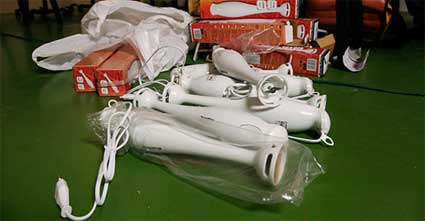
One of their plan is the “Sheep decide”. In this version, instead of a robotic device, it’s a sheep which would make a pattern.
The designers discovered that there are some kind of grass which sheep like and other they do not like. Their plan would be to seed a field with two different hayseeds, the latent picture would emerge and become visible as the sheep eats its way through the field.
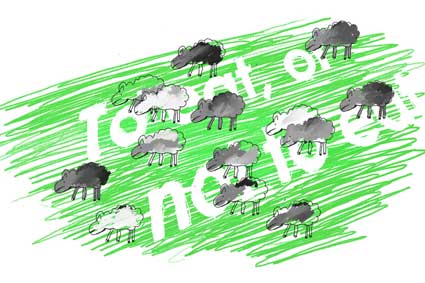
The idea made me think of this video of sheep being “re-programmed” in order to turn grazing animals into self-powered weeding machines.
autoCut is a sound-based “self-editing” video application still in development but already quite impressive. The system would make use of the many short videos shot by mobile devices which usually remain on the hard disk, or are uploaded to a video-sharing portal without any editing.
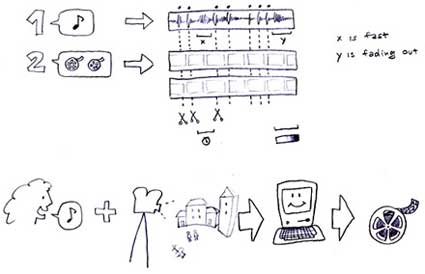
The autoCut program selects and edits the videos according to a certain music. Moreover, autoCut can handle the videos in real time, based on the rythm of live audio input.
this cut-up is made with a pd/pdp prototype, there is no after-editing, it cuts itself based on the beat of the music (crunch). there are 9 small clips, and the program chooses between them, while modifying the clips speed, position, and image composition (rotation).
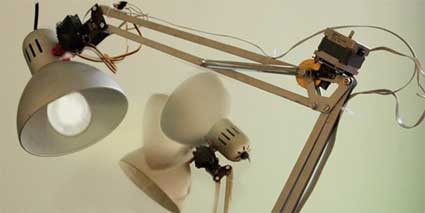
Mllamp was sick while i was in Budapest. The project experiments with emotions simulation and putting minimal intelligence into everyday things. The robotically-enhanced desk lamp has been suited up with anthropomorphous character which induces the audience to see human or pet gestures in the object’s every moves. Mllamp is an experiment for simulating emotions with putting minimal intelligence into everyday things.
Video:
Light Arbour is a lighting system which reproduces natural phenomena of light and provides an alternative and subtle communication facility between places and people. The aim is not to transmit a clear image of the landscape you see to your partner or friend but rather to send them an atmosphere, an ambiance, an impression of the intensity of the light in the mountain or at sun set for example.
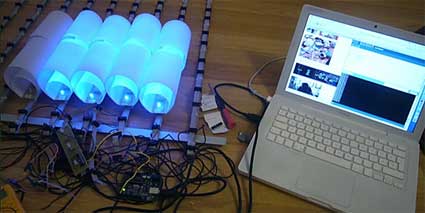
Arbour Light would be supported by a website, which would allow users to upload and use an ambient database made of the videos of Arbour Light owners and “phenomena-collectors”.
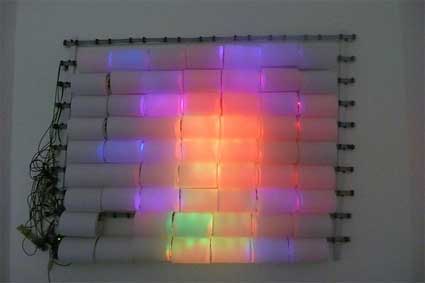
Animata is a real-time animation software for live performance. To create and move virtual characters, you load an image and attach a skeleton to it. By placing them in different depths of field, they get a 3D effect.
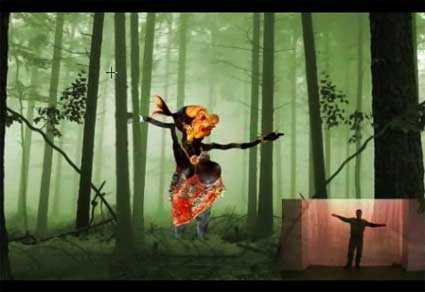
Screenshot from a video showing Reverse Shadow Theatre using Animata
The designers demo’ed the latest version of the project where characters’ movements of a shadow character animation were controlled by the movements of live actors. Furthermore, Animata allows a multi-user collaboration via the internet, thus providing an opportunity for the collective editing and creating of the performance.
Further development include:
– the animation of the characters, camera movement, and other special visual effects will be controllable by cell phones, or through multi-touch-screens or sensors.
– connecting Animata with widespread programming environments (Max/MSP, Pure Data, EyesWeb) to make use of the possibilities of these applications in the fields of image editing, sound analysis, or motion capture.
All the projects.
Image on the homepage by Kitchen Budapest.